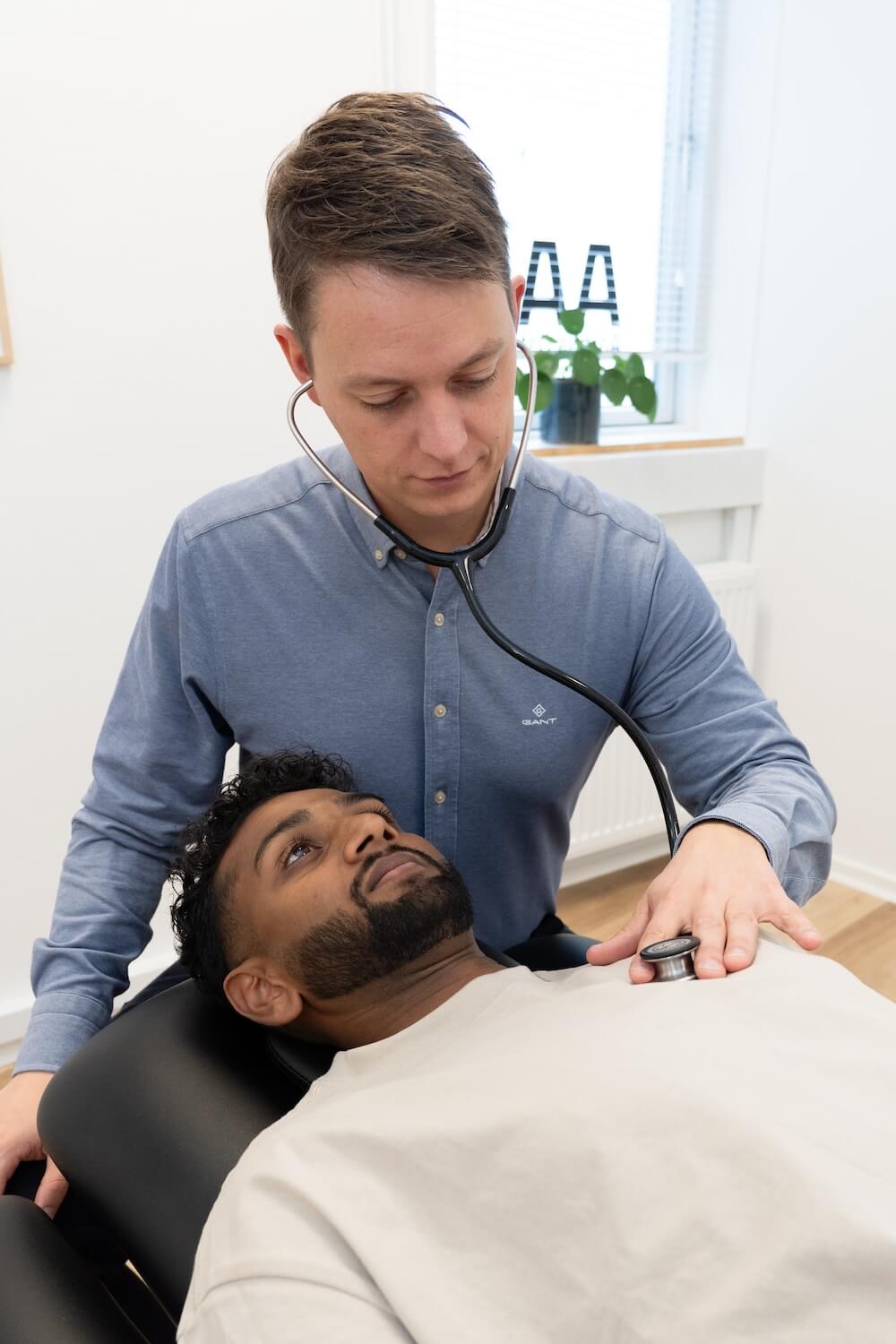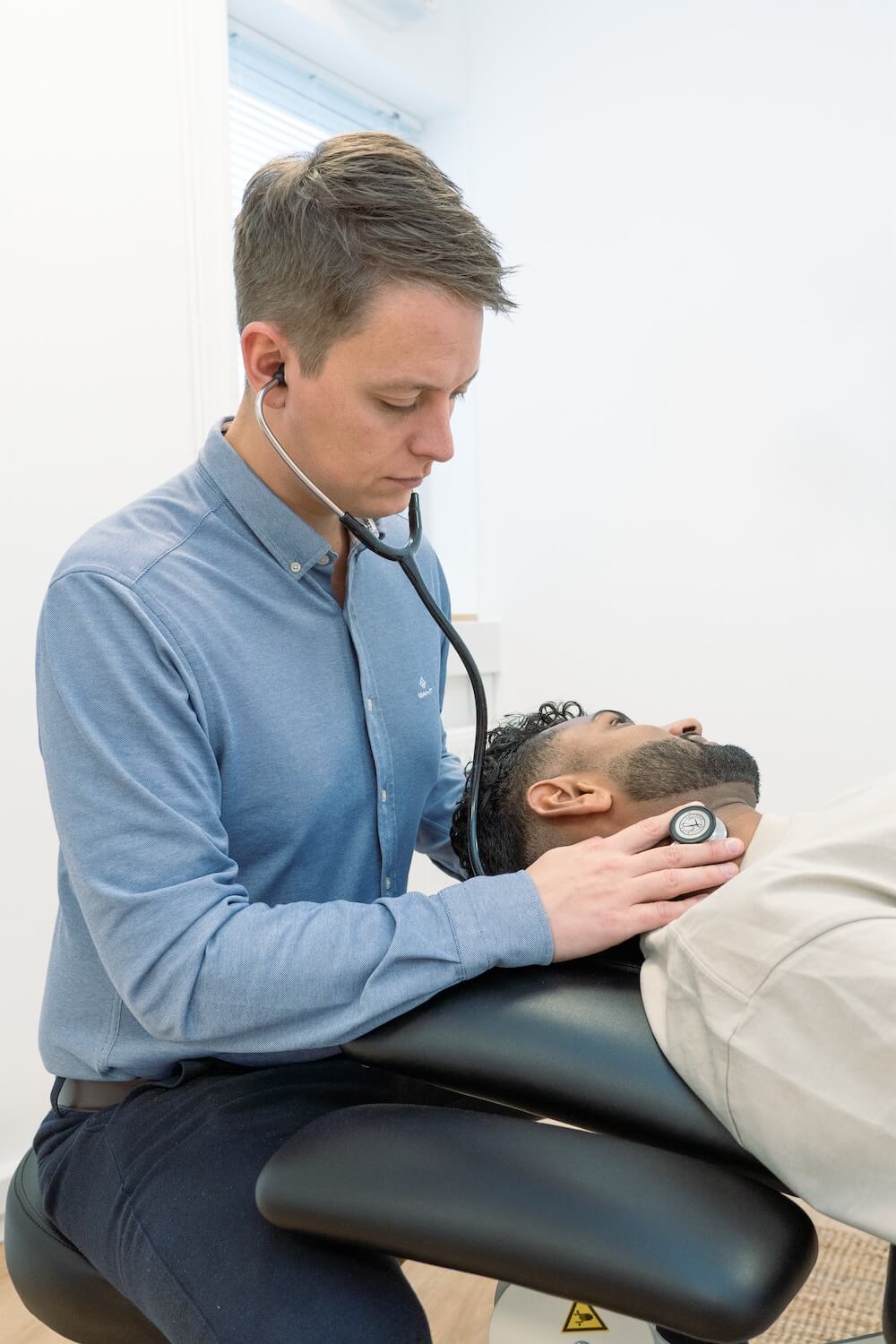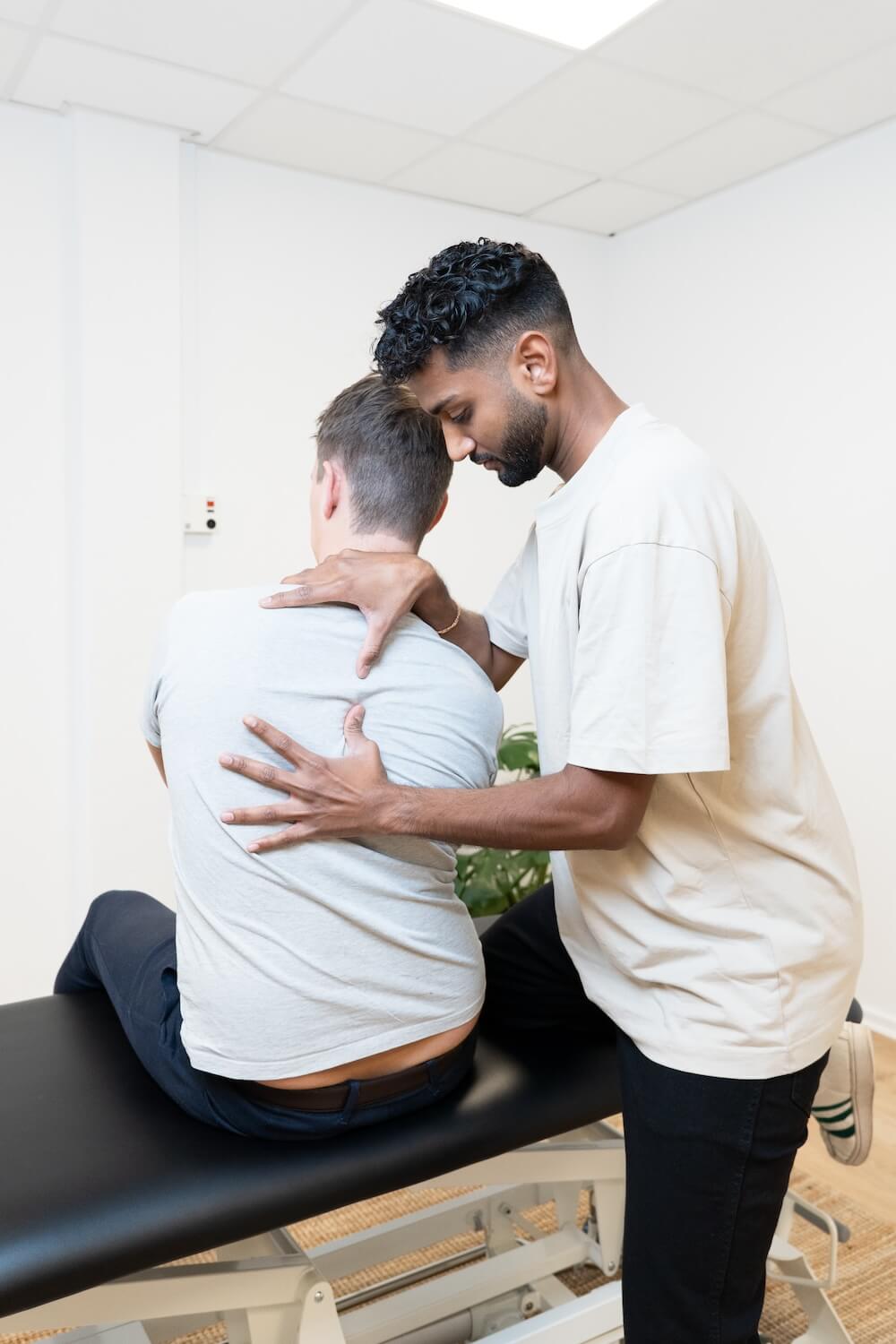We advise on problems from
Sedentary work
Learn more about the effects of sedentary work and how you can influence them
What is sedentary work?
Sedentary work is defined as an uninterrupted position for 1 hour or more. Occupations with sedentary work are particularly common in office work, surveillance and transport jobs.
In addition to your working hours, a large part of your everyday life is spent in an inactive sitting position, bent forward. This applies to everything from the sofa, to transportation, to the dining chair and when using screens.
Jump to section [Vis]
Effects of sedentary work on health
We humans are built to stand. This means that our body’s systems function better when we are not sitting hunched over and compressing the circulation in our circulatory system.
Our circulatory system (heart, lungs and blood vessels) ensures that the blood is oxygenated and pumped around the body.
Our major breathing muscle, the diaphragm, is located between the ribcage and the abdominal cavity, and acts like a piston that moves up and down, creating circulation. The diaphragm moves between 1-10 cm up and down depending on activity level.
In a resting position, the muscle moves 1 cm with each inhalation and exhalation. When working in a sedentary position, the function of the diaphragm can be compressed, the piston movement is impaired and thus the circulation of our blood is impaired. The body’s tissues such as muscles, bones, organs and cells are dependent on being supplied with nutrients and oxygen by the blood, as well as having waste products removed again. The movements of the diaphragm are also crucial for the function of our digestive system, as it contributes to the movements of the intestines (intestinal peristalsis). If the digestive system deteriorates, it can contribute to constipation, bloating, stomach pain and other problems in the gastrointestinal system (Source: ResearchGate).

Sedentary work and ergonomics
Ergonomics is the study of how the body moves and is stressed when performing a specific task. Ergonomics is about adapting the work to the person.
It requires good ergonomic adaptation of your workspace to prevent physical pain and injuries to the musculoskeletal system regardless of your starting position. Sedentary work has health consequences both in the short and long term.
Short and long-term health effects: The impact of sedentary work on the mind
Mental health
There is a negative relationship between sedentary work and mental health. Reduced physical activity is typical for long periods of sedentary work.
It can lead to reduced production of endorphins (the body’s happiness hormone), lower energy levels, create a feeling of isolation, reduce social interaction and affect sleep quality – all of which can affect mental health, depressive symptoms and quality of life. (Source: Journal of Affective Disorders).

Short and long-term health effects – The impact of sedentary work on the body
Cardiovascular diseases
Sedentary work is a risk factor for the development of cardiovascular disease. The main cause of cardiovascular disease is atherosclerosis, which leads to a reduced blood supply to the body’s tissues and a risk of blood clots or vessel ruptures. (Source: Journal of Applied Physiology).
Musculoskeletal problems
Musculoskeletal strain injuries are particularly common in the back, neck, shoulders, elbows and hands. This is because the strain on the various structures is too great in relation to what they can handle. In general, our muscles, tendons and joints need movement to increase circulation in and to the tissue, to release tension.
Sitting in the same position for a long time will cause tissue to become more ischemic, which means reduced blood supply, and thus metabolic disorders in the cells due to lack of oxygen. This can cause pain in the muscles. If a joint, muscle or tendon is stressed for a long time, it will lead to tissue overload, which is often seen in tennis elbow, golfer’s elbow, subacromial impingement syndrome and headaches.
Overweight and obesity
The risk of developing overweight and obesity is higher in sedentary work, as physical activity is reduced. Physical activity increases the body’s energy expenditure and increases resting metabolism and is therefore important for avoiding overweight.
Avoid the traps of sedentary work with regular exercise
You can do a lot yourself to prepare your body and create the right resources so that sedentary work is not as much of a burden. Regular training every week helps tissues such as bones, muscles, tendons and joints become conditioned, resilient and strengthened to better handle inactive and fixed positions. The more strengthened your tissue is, the more strain it can handle.
Physical activity is thus important for, among other things, fitness and strength, physical and mental health, and cognition – learning and concentration. (Source: SST).
Research shows that repeated periods of intermittent sitting during sedentary work, with muscle activation, have a positive effect on circulatory function. This means that factors such as the function of the heart, lungs, blood vessels, pulse and blood pressure are improved.
It is important to emphasize that a little exercise is better than no exercise.

Exercises you can do at your desk
- Stand up and stretch both arms above your head – this opens up the front of the chest and improves the movement of the diaphragm.
- Squats/knee bends – a chair can be placed behind you if balance is challenged
- Easy walking/running on site
- Push-ups at the desk
- Jumping jacks or ski jumpers
Do 10 repetitions of each exercise to get your circulation going and you’ll be ready for the rest of the day.
Healthy diet and hydration
A varied diet and a balanced fluid intake help ensure that the body’s cells have the necessary conditions and nutrients to make processes in the body function optimally. This is to maintain the body’s homeostasis. A variety of important vitamins and minerals must be supplied through the diet.
Diet advice:
- Eat a varied diet of both vegetables and fruits
- Nuts and seeds
- Fatty fish
- Fibers
- Drink 1.5 L of water a day – pay more attention when exercising
- Protein from white meat and plant-based foods

The importance of workplace design to combat sedentary behavior
ergonomic and dynamic workstations
It is important that your workplace can be adjusted to suit the person who will be doing the work – and this applies to everything from tables, chairs and electronic equipment.
Ergonomic design of the equipment is essential for allowing you to vary your sitting positions and thus avoid fixed positions that can negatively affect your health.
Strategies for creating a healthier work routine
The keyword is variety.
Change positions as often as you can to increase blood circulation in the body’s connective tissues, muscles, tendons and organs. Remember that a little is always a good thing. It doesn’t always have to be the big daily physical exercise that is required every day, but interrupting sedentary work has a big effect on health.
Implementing regular breaks
Get up when you can. Take regular breaks where you get up and stand up once an hour to avoid sedentary work from dragging on. A reminder on your phone, computer or watch can be a way to remember your regular breaks. The break can be short and can be anything from going out and getting a glass of water, taking a walk on the stairs or doing 10 repetitions of an exercise.
Conducting ‘walk-and-talk’ meetings
Grab your colleagues and go on a “walk-and-talk” meeting at meetings where it makes sense. It can also be done when you have an individual conference call while taking a walk. Again, a little is also right, and a 5-minute walk is better than nothing.
Using technology to promote movement
Technology is a big part of our everyday lives. Several types can be used to promote movement. This includes everything from exercise technology (desk/office bike, treadmill, strength training machines), VR glasses, apps with various training programs/methods, and watches to monitor and support a healthy everyday life.

Often related problems

Kissing disease

Diabetes mellitus

Eye inflammation

Padel injuries

Sedentary work

Nicotine and exercise

Shingles

